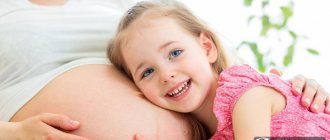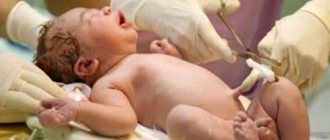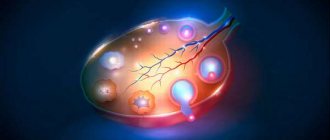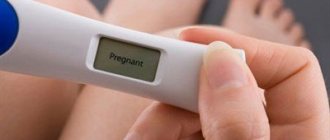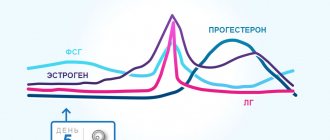What is double ovulation?
Ovulation is the release of a mature egg from the ovary. This usually happens two weeks before your period arrives. Follicles constantly mature inside the ovaries. If, when one of them reaches its maximum growth point, its membrane bursts and the egg is released, ovulation has occurred. Afterwards the algorithm is repeated.
2 ovulations in one cycle are when two follicles mature, not inferior to each other in size and characteristics. Two eggs are formed inside them. Ovulation twice a month is not a common occurrence. Eggs can form inside one or two ovaries. Can both ovaries ovulate at the same time? Yes, but they can also ripen with a time difference of several hours to 1-2 days. Thus, the answer to the question: “Can there be 2 ovulations per cycle?” has a positive answer.
Surprise for many - two ovulations in one cycle
How does this happen
In the first half of the menstrual cycle, eggs begin to mature in the ovaries, this happens under the influence of a high concentration of follicle-stimulating hormone (FSH). Which one is destined to come out depends on the size of the follicle. The largest so-called dominant follicle is the first to reach a size of 2-2.5 cm, burst and release an egg into the abdominal cavity. This happens at the moment of maximum content of luteinizing hormone (LH) in the blood.
It is believed that the remaining follicles, which at this moment have grown to 1.5 cm or more, stop developing. In the event that the menstrual cycle proceeds atypically (due to the influence of external or internal factors on the body), a repeated increase in the level of FSH and LH is possible. As a result of this, one of the “unused” follicles grows again and a new mature egg appears from it and double ovulation occurs.
Varieties of double ovulatory process
The formation of the second mature female reproductive cell during one menstrual cycle does not occur in the same way.
The difference in the process of double maturation of eggs is divided based on the following parameters:
- Cell maturation and release from follicles occur at intervals or simultaneously. The time difference ranges from several hours to a week.
- Eggs are formed inside different ovaries or one.
Confirmation of the possibility of double ovulation is the birth of twins from different eggs. Babies of different sexes, born from the fertilization of different eggs, differ from each other in their genetic code.
Signs of ovulation
Some women do not experience any signs of ovulation, while others, on the contrary, know exactly when it occurs for them. For some of them this may be natural as they can actually feel the egg being released. There are those who know when this happens because they monitor physical changes and track their ovulation.
Signs of ovulation can be different for each woman, but as a rule, you may experience:
- Changes in cervical position: The cervix becomes high, open, and moist. This indicates readiness to accept sperm.
- Changes in cervical stiffness: The cervix becomes very soft during ovulation. And during the period when a woman cannot get pregnant, the cervix is more rigid and unyielding. (More about position and stiffness with pictures...)
- Changes in basal body temperature: If you monitor your basal body temperature daily, you may notice that it is quite stable until ovulation occurs. Then it “falls” for a while, and the next day it rises sharply. This indicates that the egg has been released, i.e. ovulation has already occurred.
- Changes in cervical discharge: The mucous discharge from the lining of the cervix (cervical mucus) typically becomes similar in consistency to egg white and is heavier in the days leading up to ovulation.
These signs are quite common, and a woman can easily recognize them if she takes the time and pays attention to her body.
There are also other signs: breast swelling, bloating, spasmodic pain on one side of the pelvis, mild spotting of the skin, increased sexual desire, changes in taste preferences, increased sense of smell.
Can there be two ovulations in one cycle? No, this has not been scientifically proven. But more than one egg can be released during one ovulation (within 24 hours), which is called hyperovulation.
When do two ovulations occur in one cycle?
Repeated ovulation in one cycle occurs for various reasons. The natural mechanisms that trigger this process are not fully understood. More often, repeated ovulation occurs under the influence of artificial stimulation of ovarian function. Stimulation leads to the maturation of several follicles simultaneously. Such multiple ovulation activity is necessary for artificial insemination and infertility therapy against the background of polycystic disease. In the absence of hormonal therapy, this phenomenon is extremely rare.
For various reasons, repeated ovulation occurs in one cycle.
Why can there be two positive ovulation test results in one cycle?
Getting two positive ovulation tests within the same month is quite normal. This is because your body may need to prepare for it two or three times before the egg is mature and actually ready to be released. During this preparation, the body experiences hormonal “bursts”. These hormones are easily detected by tests, which means you may wonder if you might be ovulating twice. But, unfortunately, no - once the egg is released, hormone production also changes, preventing the release of a second egg (with rare exceptions, possible with hyperovulation).
Causes and predisposing factors
The second ovulation per cycle is a rare occurrence among women. With normal hormone synthesis, this phenomenon is considered rare. The exact reasons and mechanism for starting the repeat process have not been fully studied. Several cases of twin pregnancies with different periods of conception of babies are reliably known.
Most often, the provocateurs of this phenomenon are:
- Preparation for in vitro fertilization. Before the procedure, drugs are administered to stimulate the ovulation process.
- Taking oral contraceptives.
- Consumption of foods high in estrogen-like substances.
- Lack of regular sexual relations.
- Genetic predisposition to excessive production of female sex hormones.
Very often, the maturation of two eggs occurs simultaneously, in this case, during sexual intercourse, they are both fertilized, and twins are born.
A rare occurrence among women - the second ovulation per cycle
How often does this situation occur?
Is there a second ovulation per cycle? This phenomenon occurs rarely in medical practice. Statistics show that no more than 10% of women experience repeated increases in the concentration of hormones that contribute to the formation, maturation, development and onset of ovulation itself.
Triplets are the result of another ovulation occurring after double ovulation. About 6% of women experience this phenomenon. An increased concentration of progesterone and the onset of pregnancy are not an obstacle to the further growth and maturation of eggs.
Signs and symptoms
If two ovulations occur in one cycle, the symptoms are as follows:
- pain in the lumbar region, in the ovaries;
- increased amount of mucus secreted;
- swelling of the mammary glands;
- increase in basal temperature;
- rarely brown or bloody discharge;
- increased libido;
- weight gain;
- increased peristalsis;
- the appearance of a second strip on the test during one cyclic period.
Double ovulation, the signs of which can be reliably determined under the supervision of an ultrasound machine, is observed in 11% of the female population of the planet. With ultrasound diagnostics, the doctor determines the follicle in the process of maturation or the presence of a corpus luteum. Repeated ovulation can be detected if processes inside the ovaries are constantly monitored.
How to suspect a repeat situation
It is easy to determine that there is a possibility of ovulation twice a month by the manifestations:
- nagging pain in the lower abdomen on the right or left,
- swelling of the mammary glands,
- increased vaginal discharge,
- increased sexual desire.
The pain is unilateral or bilateral, depending on the ovary from which the oocytes emerged. If both discomfort appears on the right and left at the same time, when 1 ovary is involved, it hurts only on this side.
On the eve of “day X”, the woman notes that the volume of discharge has increased, it has become more viscous, similar to egg white. Bloody or pink coloring is a signal of follicle rupture. Mucus is observed for up to 3 days, is insignificant in quantity, and is not accompanied by pain.
In addition to these symptoms, a thermometer helps determine a favorable day for conception. Evidence of this is an increase in basal temperature (in the rectum) on the eve and on the day of ovulation.
You can purchase a test at the pharmacy, similar to a diagnostic test for determining an increase in hCG levels. A reagent is applied to the strip, which, with increasing concentration of the active substance, shows a change in the color of the strip. Regular testing allows you to determine re-ovulation.
Among instrumental methods, ultrasound is informative. It allows you to visualize with the help of equipment the location of the follicles, their size and number.
Diagnostic methods
Sometimes the symptoms described above do not appear. In this case, diagnostic methods will be informative:
- Carrying out an ovulation test at home. Under the influence of a surge of luteinizing hormone, a second line will appear on the test.
- Carrying out an ultrasound probe examination at the end of the menstrual cycle. This method is more accurate for determination.
Carrying out an ovulation test at home
Menstruation with double ovulation
Double ovulation and menstruation, what to pay attention to? The usual course of menstruation changes during double ovulation, when the follicles mature at different times. It happens that after the end of menstruation it resumes again. The interval can be from one to several days. This is possible when two full-fledged eggs mature during one cycle, ready for fertilization. This situation is considered an exception from the general mass. If the sex cells mature at the same time, this does not lead to changes in the course of menstruation.
Is it possible to detect double ripening?
When using known methods to determine the date of cell release, single or double ovulation, BT (basal temperature chart) may not be determined. Because when both cells are released simultaneously, the graph will show the overall process of luteinizing hormone (LH) release, as in the normal situation with one egg. If the ovary ruptures again after some period of time, there will no longer be such a concentration of luteinizing hormone, because progesterone will take effect. Therefore, a slight decrease and then an increase in temperature (a sign of ovulation) is not easy to notice.
But using tests during this course of ovulation, you can get a positive result again.
But the most reliable is an ultrasound, which will confirm with 100% probability that double ovulation has occurred and twins will be a good gift for the family. With its help, you can track the entire path: the appearance and development of two follicles, whether they burst together or someone else earlier, the moment the cells came out, how the corpus luteum was formed in the ovarian wall and, finally, whether both fertilized eggs were attached to the uterus.
Double ovulation can be easily detected by ultrasound
Well, the symptoms of double ovulation are no different from regular ovulation. If both cells come from one ovary, the woman may feel slight pain on its part. When production comes from both ovaries at the same time, there will be pain on both sides. Breast enlargement and tenderness are possible. Discharge from the cervix is profuse, transparent and viscous, like egg white.
Egg white discharge is a sure sign of ovulation.
If the cell re-emerges after a few days, then after the first stage of ovulation, all these sensations can repeat again, which in combination, for example with ultrasound, will indicate double ovulation in a given menstrual cycle.
How does it affect pregnancy?
The syndrome of double development of female germ cells does not have a noticeable effect on the course of pregnancy. The process of conception is determined not only by the ovulation process, so conceiving twins is not a common occurrence. The maturation of several female germ cells occurs more often than others in women belonging to the Negroid race, European women take second place, and in Asian women this is an extremely rare phenomenon. Based on this, we can talk about a genetic predisposition to such a deviation.
Do I need to see a gynecologist?
Double maturation of eggs, as a one-time phenomenon, does not require special attention. In cases of systematic manifestation of a repeated ovulatory process during one cycle, it is recommended to mark it on the calendar to determine safe and active days for possible conception. With a genetic predisposition to multiple pregnancy, double ovulation is not a pathological phenomenon. In the absence of genetic conditions or other factors, you need to visit an endocrinologist to identify hormonal dysfunctions. Typically, this type of maturation of female cells does not require treatment.
